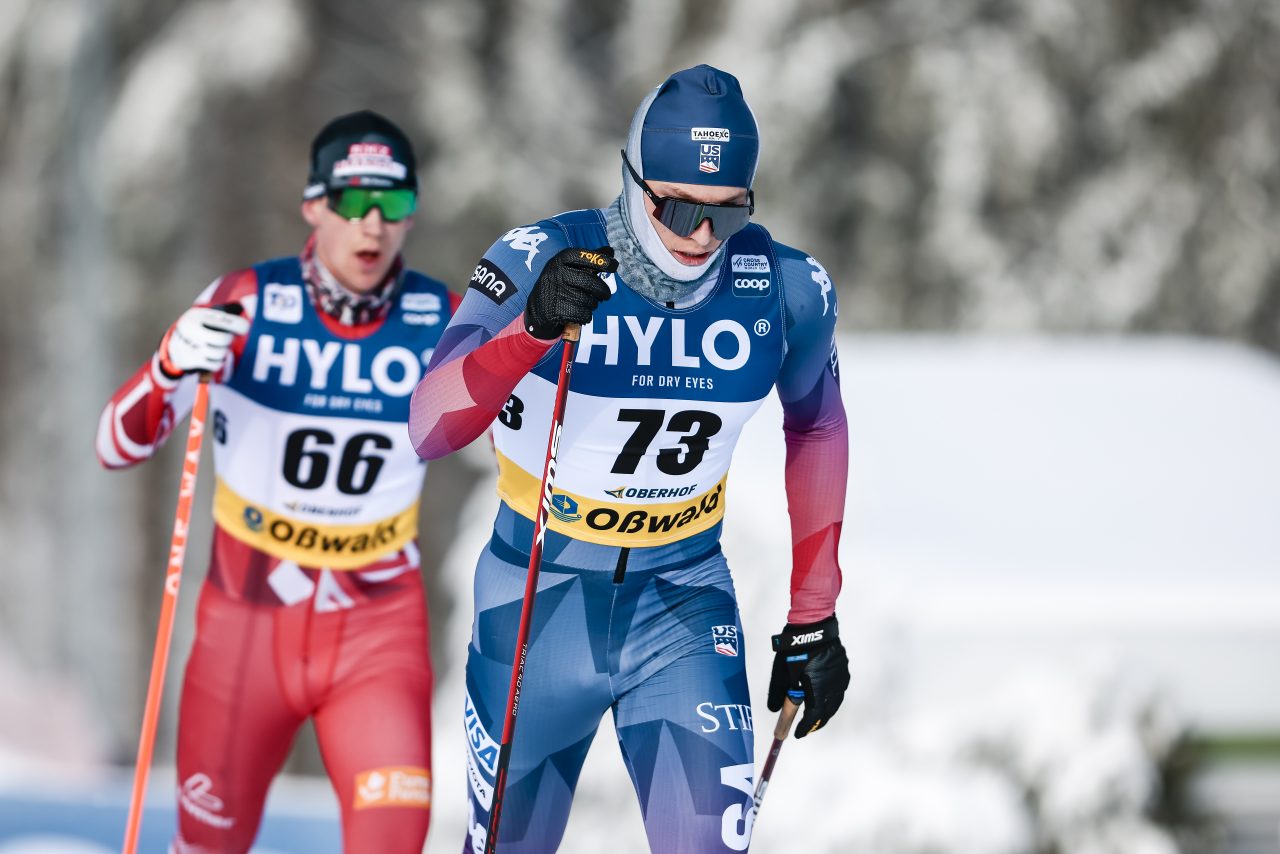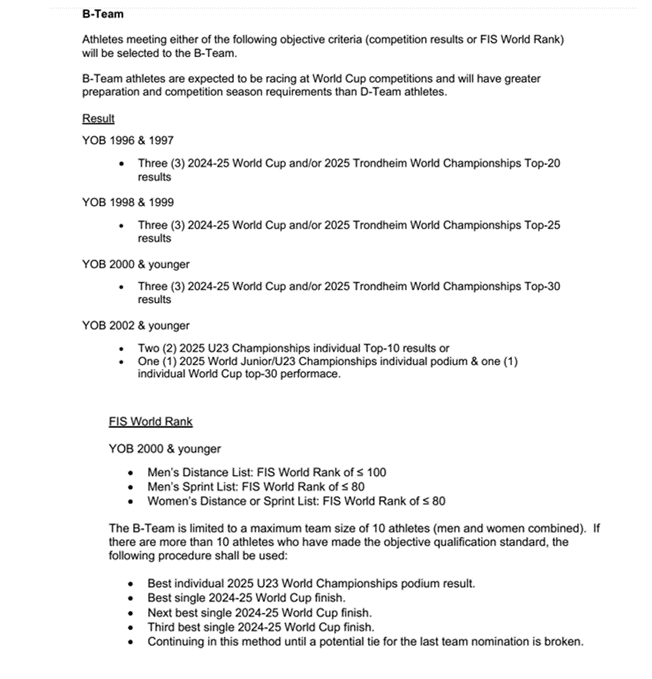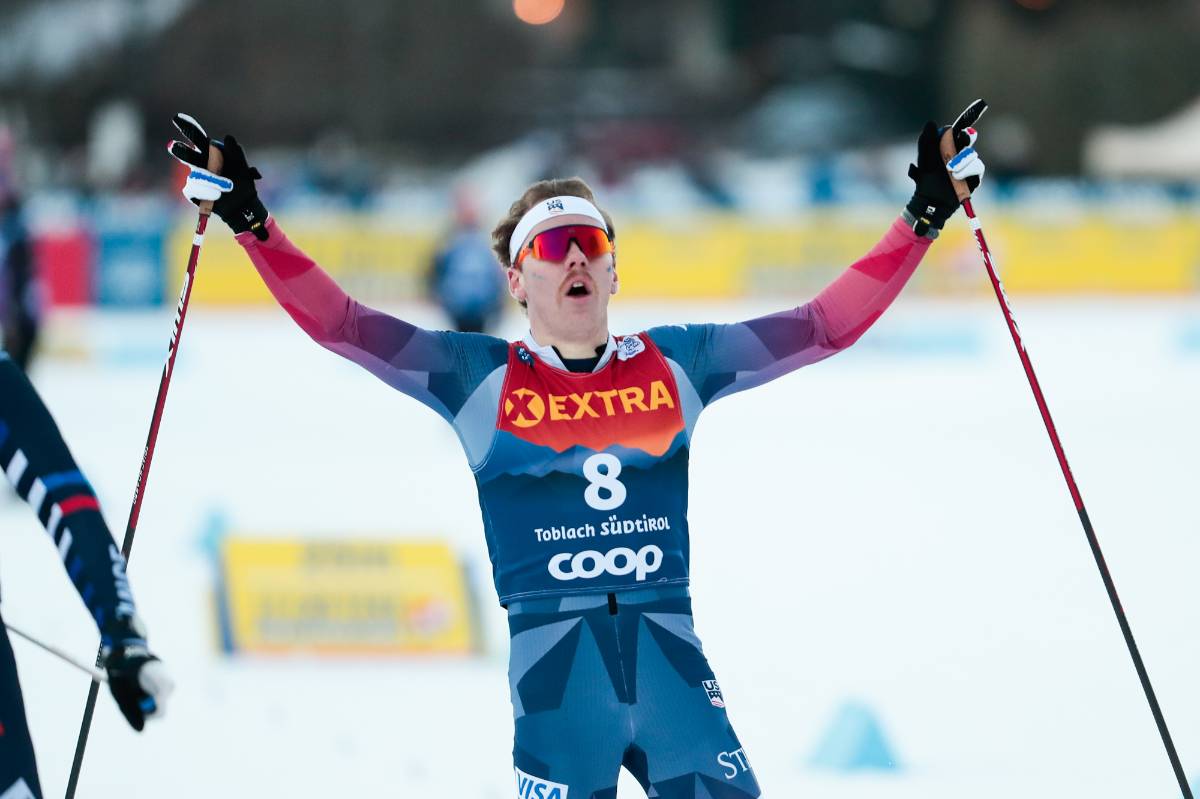
Every fall the U.S. cross-country ski team announces its new roster. But there are teams within the team which makes it a little complicated to figure out exactly who belongs where. With designations of A, B, and D teams. The method for how members are selected to these teams is well documented, and it’s all contained in a public document on the U.S. team’s website. But as you’ll see, that process is going to change for the 2026 season.
What’s less well known, and not discussed as often, are the differences from the athletes’ points of view. So, what exactly does it mean for a skier to be chosen to one of the different teams? That and other questions were answered when FasterSkier spoke with Chris Grover, the U.S. team’s head coach, about the team selection process, upcoming changes in that process, and at least one surprise announcement for the upcoming race season.

What Does it Mean to Be on the A, B, or D Team?
From the athlete’s point of view, what exactly is the difference between qualifying for the A, B, or D teams? The answer, as far as the differences between being an A team or B team member is easy. As Grover described it, “right now, there’s no difference between A and B team support.” Grover noted that, “it wasn’t always like that. There was a while when the A team was fully funded and the B team was partially funded, but that stemmed from the 2008-09 financial situation. The organization took a big hit and had to cut a lot of staff, and we all took pay cuts. At that point the B team had to fund their own travel to World Cup.” But now, “all of the same resources are available (for A and B).” Grover hopes that the days of funding gaps are all in the past and that the current differentiation between A and B remains mostly a vestige of historically bad times. That bit of history may explain why some fans think there’s a big difference between being on the A and B teams, when in fact, there really isn’t any today, at least in terms of team support for an athlete.

In terms of what the team expects of A and B teamers, there is once again no difference. “All of those athletes (A and B team members) are expected to be racing World Cup. There may be some younger athletes also racing in NCAAs and U-23s, but the A team and the B team are primarily designed to be athletes who are competing and having success on the World Cup.”
So why even have an A and B team differentiation? Part of the reason goes back to that difficult history around 2008 and to guard against changes in funding. “You never know what’s going to happen in the future, we could have another financial meltdown, and we’d have to be able to prioritize our funding.”
So, there you have it. The difference between being an A and B team member from the athlete’s view, as of today; none, but don’t kid yourself, it’s still nice to have the title “A team member!”

But the world of support for D team athletes is markedly different. “All D team athletes pay their own room, board, and travel. That includes going to training camps and coming to World Cup. We try to support them with coaching, medical, and sports science support. We have athlete career and education services, which includes tuition reimbursement and career placement. We’re obviously paying for coaches and vans, but for the most part they pay their own travel.” When it comes to the impact on an athlete, the big difference is between D team membership versus A or B team status.
When you’re a struggling skier trying to keep your place on the team, the difference in support is a pretty significant void in financing which can be onerous for your average D team member. To help fill the gap, the NNF (National Nordic Foundation), which is privately funded, and has its own formula to determine how much financial aid each athlete receives, helps provide financial support. “Athletes who race more, have more starts, and have better performances get more money from the NNF,” said Grover.

Changing Qualification Criteria
But big changes in the team qualification process are on the horizon, as the criteria for the 2025/26 season will be different from the current method. Grover outlined the highlights of the changes.

“There’s no way to qualify for the A team via world rank, like we’ve had. We’ve made it totally objective, based on World Cup and World Championships. We wanted the A team to be athletes that were meeting a certain standard on World Cup. For the A team, it’s all about World Cup performance (not points) and World Championship performance.” The changes Grover points to were driven by looking back and realizing that “we’ve seen that younger athletes can often make the A team without having much success on the World Cup. This (change) is to indicate that the A team is for World Cup and Championship level performers.”

Currently, A team members could qualify based upon World Cup ranking, or high individual World Cup/World Championship race finishes. As part of the calculation, there is a sliding scale formula for qualification based upon a combination of year of birth and World Ranking.

For the 2025/26 season there will only be three ways to make the A team and none of them involve an athlete’s age. Qualifying will be based upon either a top 15 ranking in either Sprint or Distance classifications from the prior season of World Cup competition, achieving a podium in the World Cup/World Championships the prior season, or having 3 top 12 finishes in Distance or Sprint competitions at the World Cup/World Championships from the prior year. Gone from A team qualifying is the convoluted year of birth calculations.

Age calculations are now incorporated into B team qualifying and reflect the concerns about younger athletes who could make the A team and have limited World Cup success. B team qualifications will occur through a combination of age and World Cup/World Championship results, and U23 and Junior Championship results. World rankings come into play only for athletes born before 2000. And B team members will still be expected to race at World Cup competitions.
Another big change will be a cap on the number of athletes on the B team. The team will be limited to a maximum of 10 athletes (men and women combined). There is then a tie breaking procedure in the event that more than 10 athletes qualify for the B team.
D team qualification will be based upon competition results from World Cup races, U23 World Championships performance, and World Junior Championships. Like the B team, there will also be a pathway based upon FIS World rankings.
To address any unforeseen inequities, discretionary selections are still allowed.

Some of the change, particularly with the B team cap, is financially driven. “We have to fund all those athletes’ room, board, and travel, but we also have to provide a staff support network that’s big enough to take care of them all. That includes wax technicians, coaches, and physical therapists.” All of that support takes money and there isn’t a limitless pot.

Grover emphasized that, “being on the U.S. ski team doesn’t give you any kind of start rights on the World Cup, they’re not related whatsoever. Making the U.S. ski team is totally separate from qualifying for any sort of competition trip.”

Like many aspects of the American squad, the selection process to make the team is different than for most other nations. For the Americans, “you either qualify objectively for the next season or you don’t, we do sometimes use coach’s discretion if we feel somebody has fallen through the cracks—but we don’t use it very often. Often when Norwegians or Scandinavians talk about a purely objective selection method, they will refer to it as an American system. Many other national teams don’t have objective criteria for their World Cup, National, or World Championship teams. They are using a ton more discretion. In the past, some of our main competitors have used almost 100 percent discretion.”
So that’s what all of the alphabet soup spells out when talking about U.S. team membership.
New Look For a New Season: Another Truck and Larger Team Quotas

Grover also gave FasterSkier a head’s up on a team upgrade for this winter’s World Cup season. “We have a second wax truck that will be going on the road with us this winter which is going to carry our Wintersteiger grinding machine … which will also give us four more work stations, which we absolutely need because the team has gotten so big. We and Norway have the biggest quota in the world right now, because they have the men’s Overall winner and we have the women’s, so we can start 15 athletes between men and women, as Norway can, but that’s bigger than every other nation. We have 22 different athletes coming to World Cup in period one. So now we have two trucks.”
Trucks aren’t cheap, and Grover is quick to express his appreciation to the U.S. Olympic Committee for the funding role they played in purchasing a second truck, in addition to private donors who aided in the purchase. It cost over €200,000 Euros (about $216,00 U.S.D), for just the truck, not including any of the equipment like grinders which go into it. It’s a good upgrade for a team which continues to seek improvement in every aspect on and off the competition field.
Thank you to Chris Grover for taking the time to have this discussion with FasterSkier



